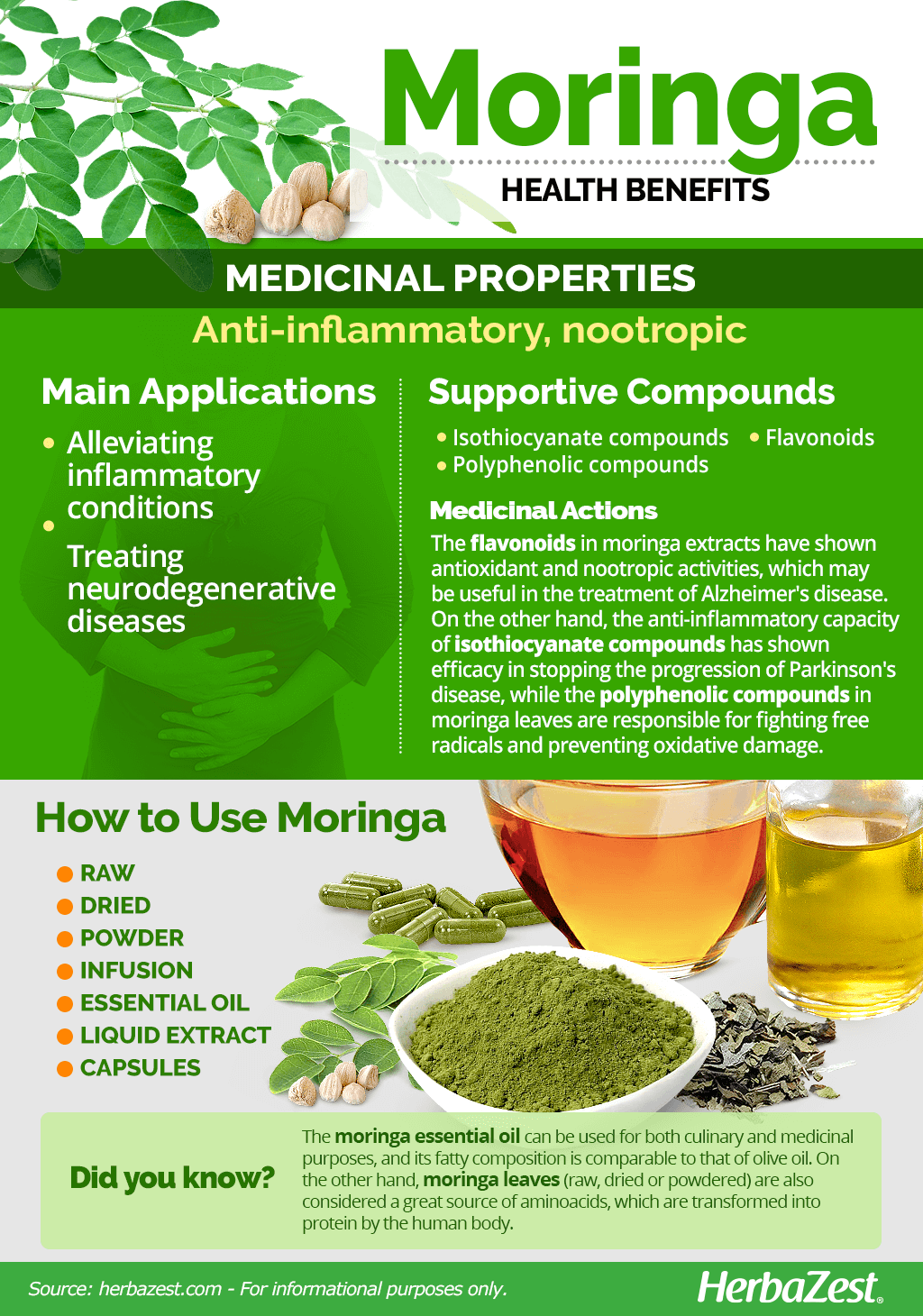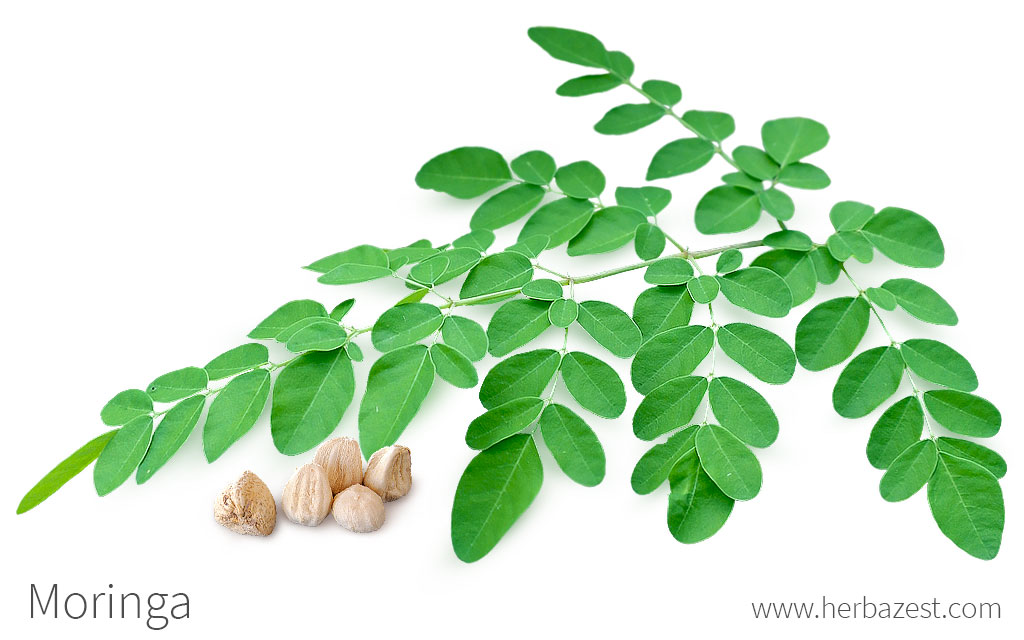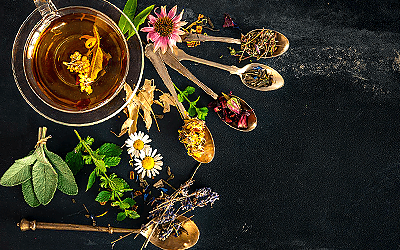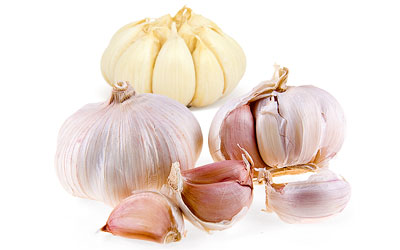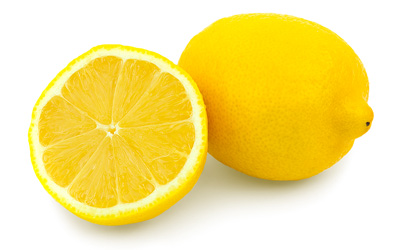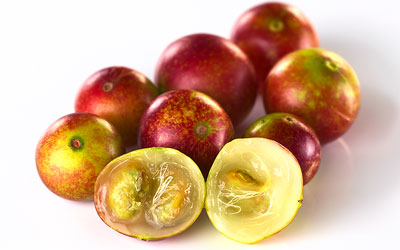The origins of moringa, also known as "drumstick tree," "horseradish tree," "mother's best friend," "miracle tree," "the never die," and "ben oil tree," can be traced to Africa and southern Asia. With great nutritional value, moringa leaves have gained popularity as a superfood. However, the medicinal properties of both bark and leaves of the tree have been proven useful for the treatment of a variety of health conditions, and promising studies have suggested further potential applications of moringa.
Moringa Medicinal Properties
Health Benefits of Moringa
All parts of the moringa tree (roots, barks, leaves, flowers, and pods) have been traditionally used as a source of nutrition and medicinal properties, many of which are still under investigation, although a growing number of scientific studies are revealing potential moringa's pharmacological applications. Although folk medicine uses all parts of the tree for treating a wide variety of health conditions, the following are scientifically proven moringa benefits:
Alleviating inflammatory conditions. The concentration of antioxidant compounds in moringa has been shown useful for the treatment of chronic inflammation involved in health conditions, such as obesity, diabetes, cardiovascular diseases, autoimmune conditions, edema, arthritis, and irritable bowel syndrome (IBS).
Treating neurodegenerative diseases. Moringa properties include nootropic and neuroprotective actions that have proven useful for the treatment of age-related diseases, such as Alzheimer's.
Preliminary studies have shown that moringa's properties also comprise hypoglycemic, antimicrobial, and hepatoprotective actions. Moringa leaves and pods are also considered a great source of protein, vitamins, and minerals, and they have been consumed for millennia in their native lands for treating anemia and preventing malnutrition.
How It Works
Moringa health benefits are related to its high levels of antioxidant compounds, mainly flavonoids and isothiocyanate compounds with strong bioactive properties.
The combined action of these antioxidant compounds has been shown to reduce the amount cytokines, which are proteins released by cells and play a key role in regulating the immune system's response to inflammation and infection.1 This action is thought to be responsible for reducing inflammation involved in chronic diseases, such as cardiovascular, immune, and metabolic conditions, as well as ulcers, edema, irritable bowel syndrome (IBS), and urinary tract infections (UTI).
As the use of flavonoids for the treatments and prevention of neurodegenerative diseases is being actively investigated, promising studies report that extracts of moringa leaves exhibit both antioxidant activity and nootropic effects, which can be useful for the treatment of dementia and Alzheimer's disease.1
On the other hand, isothiocyanate compounds isolated from moringa have shown to significantly halt the progression of Parkinson's disease by blocking the pathway of inflammatory signals.2
Additionally, moringa's antimicrobial properties have proven effective against common strains, such as Staphylococcus aureus, Enterococcus faecalis, Escherichia coli, and Salmonella. Furthermore, polyphenolic compounds in moringa leaves, such as chlorogenic acid, rutin, quercetin, and kaempferol, are thought to be responsible for fighting free radicals and preventing oxidative damage.3
MORINGA IS CONSIDERED A GREAT SOURCE OF AMINO ACIDS, WHICH ARE THE BUILDING BLOCKS OF PROTEIN IN THE HUMAN BODY.
Other herbs with anti-inflammatory benefits are cabbage, devil's claw, and turmeric, whereas neuroprotective and nootropic properties can also be found in ashwagandha, ginkgo, and sage.
Moringa Side Effects
Moringa is considered safe in normal doses; however, excessive consumption must be avoided in order to prevent hepatotoxicity.
Moringa Cautions
The bark of moringa may cause uterine contractions and should be avoid during pregnancy. Likewise, those taking drugs for diabetes should seek medical advice before consuming moringa supplements since they can exacerbate the hypoglycemic properties of the medicine.
- Medicinal action Anti-inflammatory, Nootropic
- Key constituents Flavonoids, isothiocyanate compounds, polyphenolic compounds
- Ways to use Capsules, Hot infusions/tisanes, Liquid extracts, Food, Essential oil, Dried
- Medicinal rating (2) Minorly useful plant
- Safety ranking Safe
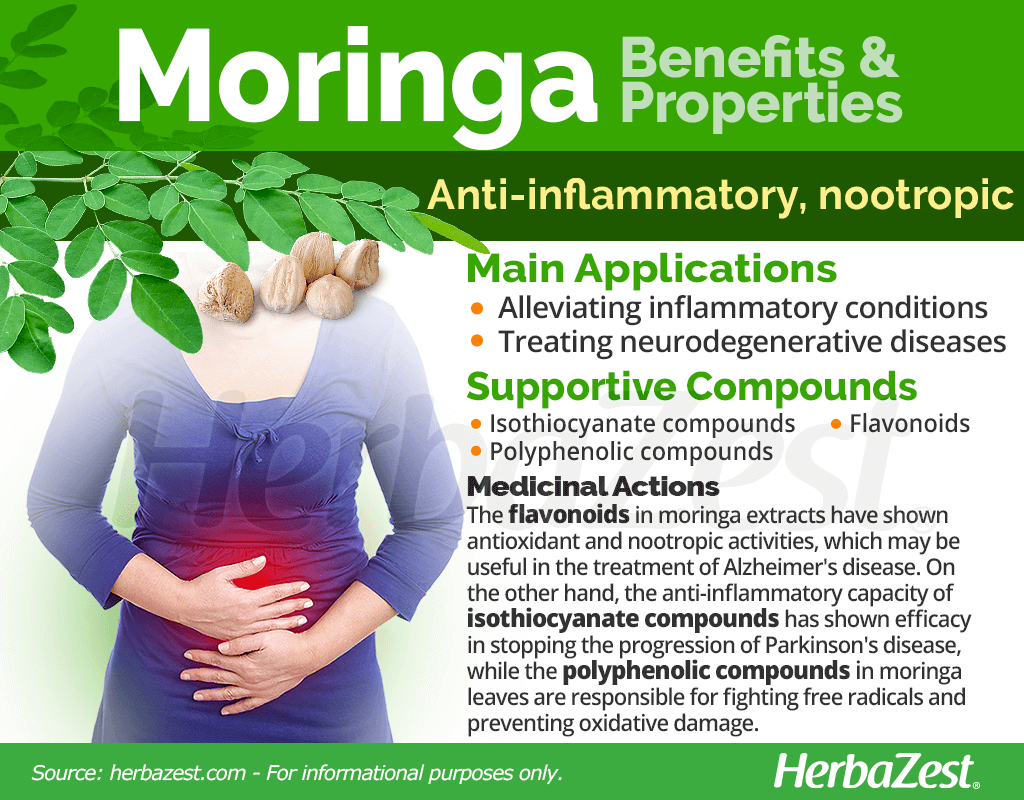
Moringa Nutrition
The nutritional value of moringa hails from its outstanding levels of certain vitamins and minerals. Moringa leaf powder is not only rich in protein and dietary fiber, both of which contribute to maintaining satiety and slowing down glucose metabolism. It also provides healthy fatty acids in amounts similar to olives, which explains its popular use as a leafy green in Africa and southern Asia, its native lands.
The most abundant mineral in moringa leaves is calcium, necessary for strong bones and blood clotting, among other important body functions. It also contains iron, essential for maintaining adequate levels of hemoglobin and preventing anemia.
Moringa leaves are also a powerhouse of nutrients with great antioxidant properties, namely vitamin C (ascorbic acid) and provitamin A (from carotenoids), both of which not only aid mineral absorption, but also enhance immunity, protect the body against dangerous pathogens, and promote healthy eyes and skin.
100 G OF MORINGA LEAF POWDER PROVIDE 500 CALORIES AS WELL AS 67, 51, AND 133% OF THE DAILY VALUE FOR PROTEIN, HEALTHY FATS, AND DIETARY FIBER, RESPECTIVELY.
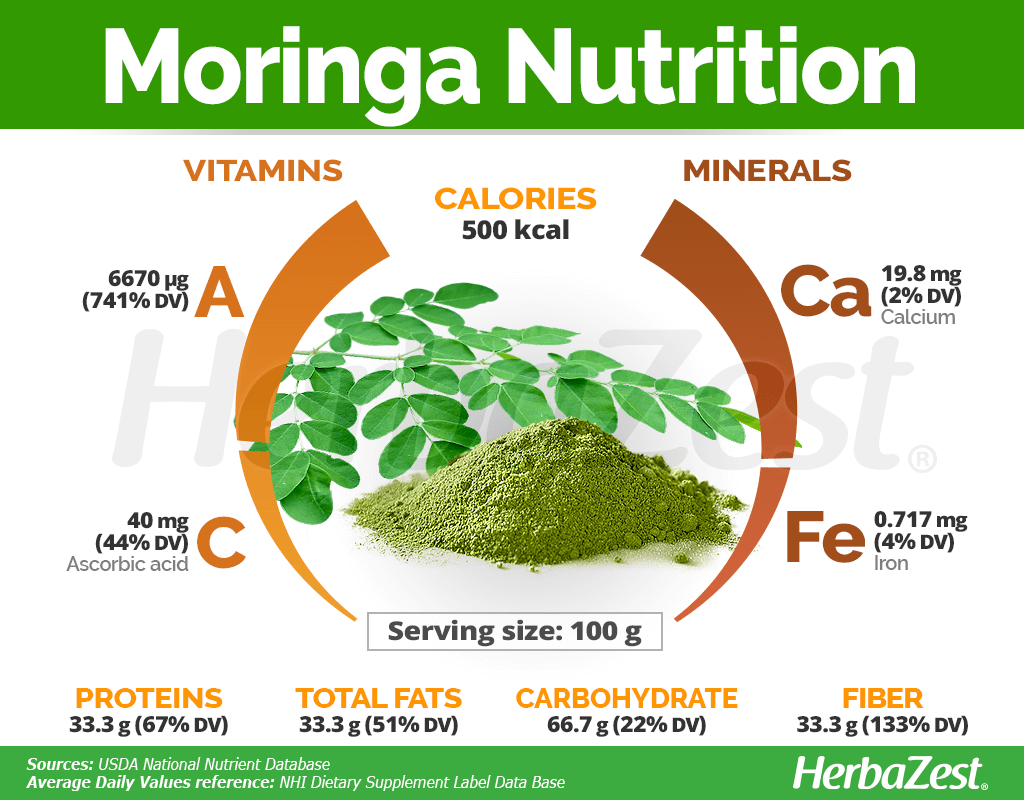
How to Consume Moringa
All parts of the moringa tree have been traditionally consumed in both culinary and medicinal forms, in order to reap their medicinal properties and nutritional value.
Natural Forms
Raw. In their fresh form, moringa leaves are a popular snack that provide great nutrition and medicinal benefits when added to salads, soups, and other culinary preparations.
Dried. Once dried, whole moringa leaves can be added to baked goods, smoothies, and many other culinary and medicinal preparations.
Powder. The dried leaves of moringa are ground into a fine powder that can be added to smoothies, baked goods, and more. This is the most popular way of reaping moringa health benefits and nutritional value.
Tea. Dried or powdered, moringa leaves can be brewed into a warm infusion with anti-inflammatory and analgesic properties. Moringa tea can soothe gastrointestinal discomfort, lower blood pressure, and help reduce blood sugar levels.
Herbal Remedies & Supplements
Essential oil. Obtained from cold pressed seeds, moringa essential oil – also known as “ben oil” - is rich in unsaturated fatty acids as well as in vitamins A and C. In this form, the emollient and anti-inflammatory properties of moringa nourish and moisturize the skin, also helping heal superficial wounds, scratches, and bug bites.
Liquid extract. Moringa extract offers high concentrations of antioxidant, anti-inflammatory compounds that can help control blood sugar levels, hypertension, and gastrointestinal problems, such as irritable bowel syndrome (IBS).
Capsules. This one of the most popular ways of consuming moringa, due its availability and practicality. Moringa capsules and tablets come in standardized doses that allows for proper absorption of their antioxidant compounds.
MORINGA OIL CAN BE USED FOR CULINARY AND MEDICINAL PURPOSES, AND ITS FATTY COMPOSITION IS COMPARABLE TO THAT OF OLIVE OIL.4
- Edible parts Flowers, Inner bark, Leaves, Root, Seedpod
- Edible uses Protein
- Taste Tangy
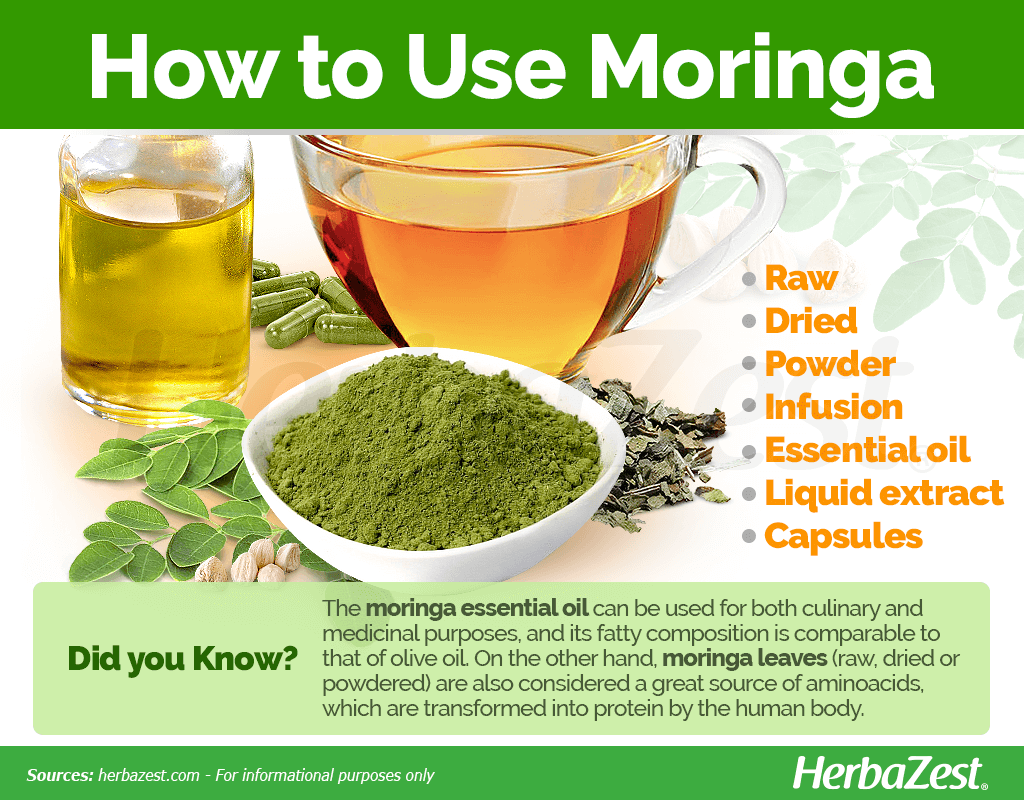
Growing
The moringa tree, also known as "miracle tree," "drumstick tree," "horseradish tree," "mother's best friend," "miracle tree," "the never die," and "ben oil tree," is a deciduous species, native to southern Asia and Africa, although nowadays it thrives in both dry and humid tropical and subtropical forests of many countries around the world. The moringa tree prefers elevations below 1,970 feet (600 m), but it can grow up to 3,940 feet (1,200 m) in tropical areas.
Growing guidelines
The moringa tree prefers a well-drained sandy loam or loam soil and grows best between 77-95°F (25-35°C), but will tolerate up to 118°F (48°C) in the shade and can survive a light frost.
Moringa can be propagated by seeds, transplants, or hard stem cuttings. Seeds can be planted 20 inches (50 cm) apart in rows spaced 39 inches (1 m) apart. If using raised beds, these should be up to 24 inches (60 cm) wide, with a plant space of 39 inches (1 m) apart. Seedlings can be grown trays, pots, plastic bags, or seed-beds before being transplanted.
The moringa tree usually thrives without the need of fertilizer, thanks to its deep root system. However, commercially grown moringa is fertilized at the moment of planting with nitrogen, compost, or manure in order to ensure better yields.
Moringa seedlings require irrigation immediately after planting to promote root development. If growing moringa in dry climates, the seedlings will need regular irrigation during the first two months. Once the roots are established, the moringa tree rarely needs water, and it is drought resistant.
Straw or plastic mulch should be applied around the base of the young trees, and the soil will need frequent cultivation to prevent weed growth.
The moringa tree will need frequent pruning in order to stimulate branching, increase yields and make harvesting easier.
Moringa leaves can be harvested after at least one year, once the plants have grown up to 4.9-6.6 feet (1.5-2.0 m). The leaves are collected by snapping the tender stems from the branches.
Moringa is highly resistant to pest and diseases; however, root rot may be caused by excessive watering, and the risk of mites is higher during extreme cold and dry conditions.
Some animals, such as cattle, sheep, pigs, and goats have a preference for moringa seedlings, leaves, and pods. The young trees can be protected by a fence or a hedge around the area of cultivation.
- Life cycle Perennial
- Harvested parts Flowers, Roots, Leaves, Fruit, Bark
- Light requirements Full sun
- Soil Well-drained
- Growing habitat Tropical regions
- Plant spacing average 0.5 m (1.64 ft)
- Growing time One year
- Propagation techniques Stem cuttings
- Potential insect pests Mites
- Potential diseases Root rot
Additional Information
Plant Biology
The moringa tree is really a woody, perennial shrub that can be 16-32.8 feet (5-10 m) tall, with a trunk diameter of about 18 inches (45 cm). The bark is usually pale, grey-white, and usually smooth. The pale green moringa leaves grow in an alternate pattern and have an oval shape, with many leaflets. The flowers, on the other hand, are 0.4-0-8 inches (1-2 cm) long, with white or cream petals, whereas the pods are 0.4-0.6 inches (10-15 mm) long, brown when ripped, and each one contains three rounded seeds.
Classification
Moringa (Moringa oleifera) belongs to the Moringaceae family, also known as the horseradish family, which compresses over 13 species of woody shrubs or small trees and shrubs. This family is represented by a single genus: Moringa.
Varieties and cultivars of moringa
From the 13 species of moringa, two of the most popular ones for commercial purposes are the Indian moringa (Moringa oleifera), which is indigenous to parts of Himalaya and India, but also grown in most continents, and the African moringa (Moringa stenopetala), which is widely cultivated across Kenya and Ethiopia.
While no breeding has been done in Africa, some popular cultivars in India are 'Jaffna,' whose large pods range from 23.6-39.4 inches (60-100 cm), and 'PKM1,' with short stems, developed for the production of immature fruits.
Historical information
Northern India and Pakistan are considered the cradle of Moringa oleifera, and the history of this shrubby tree can be traced back to 150 BCE, through written records prove ancient royals used moringa leaves and fruits for cognitive function and skin health. Moringa leaf extract was also given to Indian soldiers in order to improve their performance in the war field. It is believed that thanks to the energy- boosting, stress-relieving effects of moringa, these warriors were able to defeat the army of Alexander the Great.
In Ancient Egypt, moringa oil was an essential ingredient for embalming the dead, and it was also a common offering in temples during religious festivities.
After centuries of commercial trade, the moringa tree is now widely distributed across tropical areas of Africa, Asia, the Caribbean islands, and South America.
Economic Data
The largest producer and supplier of moringa in the world is India. In 2017, this Asian country was responsible of an estimated amount of nearly 551 tons of moringa global exports (including leaf powder, seed oil, and other products), with about 221 tons imported by Europe.
Other Uses
Industrial uses. Moringa oil is used as a lubricant for fine machinery, such as timepieces, to extend its function and prevent deterioration.
Cosmetic industry. The essential oil of moringa seeds has the capacity to absorb and retain volatile substances, and these properties are highly appreciated in the perfume industry where moringa is used to stabilize scents.
Fodder. The high nutritional value of moringa leaves is not only reaped by humans, but also used to feed cattle in the areas where the tree naturally grows.
Water purification. Some proteins in the byproduct of moringa oil extraction are able to separate mineral and organic particles in juice and beer industries and have also been used to purify the muddy water from the Nile river in both Egypt and Sudan for human consumption.
Fertilizer. The extract of moringa leaves contain growth enhancing hormones that can be sprayed to the plants in order to promote optimal development, as well as making them more resistant to pests and diseases.
- Other uses Animal feed, Cosmetics, Fertilizer
Sources
- African Journal of Food Science, Moringa oleifera: An underutilized tree in Nigeria withamazing versatility: A review, 2015
- Ancient Egyptian Temple Ritual: Performance, Patterns, and Practice, p. 69
- Asian Vegetable Research & Development Center, Suggested Cultural Practices for Moringa
- Clinical Naturopathic Medicine, p. 1536
- Fundamentals of Herbal Medicine, pp. 1798-1800
- Handbook of Medicinal Herbs, Second Edition, p. 390
- Journal of Innovations in Pharmaceuticals and Biological Sciences, Moringa oleifera Lam: Its Potentials as a Food Security and Rural Medicinal Item, 2012
- Netherlands Ministry of Foreign Affairs, CBI-Centre for the Promotion of Imports from developing countries, Exporting moringa to Europe
- Senckenbergiana Biologica, On the introduction of a tropical multipurpose tree to China: traditional and potential utilisation of Moringa oleifera Lamarck, 1996
- The African and Arabian Moringa Species, pp. 3-5
- The Miracle Tree: Moringa Oleifera, p. 2007
- Toxicological Survey of African Medicinal Plants, p. 543
- University of California, Moringa — the next superfood?
- USDA Branded Food Products Database, Moringa Powder
- Vegetables, pp. 392-395
Footnotes
- Nutrients. (2018). Nutraceutical or Pharmacological Potential of Moringa oleifera Lam. Retrieved February 25, 2020 from https://www.ncbi.nlm.nih.gov/pmc/articles/PMC5872761/
- Rejuvenation Research. (2017). The Isothiocyanate Isolated from Moringa oleifera Shows Potent Anti-Inflammatory Activity in the Treatment of Murine Subacute Parkinson's Disease. Retrieved February 25, 2020 from https://www.liebertpub.com/doi/full/10.1089/rej.2016.1828
- Plant Foods for Human Nutrition. (2009). Antioxidant activity and total phenolic content of Moringa oleifera leaves in two stages of maturity. Retrieved February 25, 2020 from https://www.bionity.com/en/publications/198974/antioxidant-activity-and-total-phenolic-content-of-moringa-oleifera-leaves-in-two-stages-of-maturity.html
- Nuts and Seeds in Health and Disease Prevention. (2011). Academic Press. Elsevier
